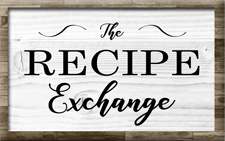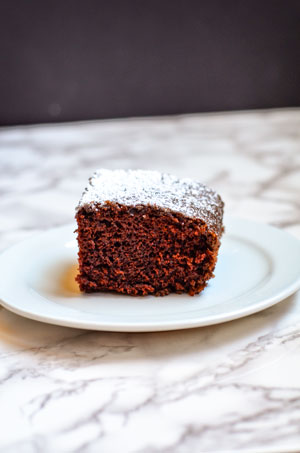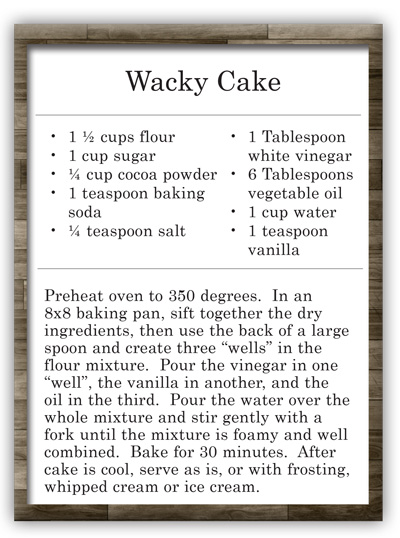No eggs, no milk, no butter
Article and photo by Lisa Crockett


There are some recipes that are kind of magical, taking the simplest of ingredients and turning them into something special: BLT sandwiches, pasta with Parmesan and cream or a perfectly cooked omelet. I love all of these dishes because I can make them quickly and they never fail to leave me satisfied. I have a pretty vast repertoire of such recipes that allow me to satisfy my desire for delicious food and also my desire to get out of the kitchen and do other things. My ability to balance deliciousness with distractibility is one I pride myself on in nearly all of my kitchen endeavors, and the cake recipe I’m sharing here may be my best find yet. A few minutes in the kitchen and then a quick pop into the oven results in soft, rich chocolate cake. Even better, there are very, very few dishes to wash when it’s all over.
This is a cake my grandmother would have made with ingredients on hand. The name “wacky cake” derives from the fact that this recipe uses no eggs, milk or butter. Instead, its pleasant texture comes from oil and its lightness comes from the chemical reaction that results when baking soda and vinegar react with each other. The origins of this cake are a bit hard to pin down, but it’s been around for nearly 100 years and seems to have been created to satisfy the cravings of Depression and World War II-era bakers who may not have had the means or the opportunity to purchase fresh ingredients.
This thrifty resourcefulness is still helpful today, when I need cake, but I don’t want to go to the store. Everything in this dessert is in my pantry, pretty much at all times. On its own, this cake is decadent enough to satisfy my every chocolate craving while still being light enough for me to justify eating it at breakfast (it is vegan, after all). While making this cake is just as easy as making a cake from a box mix, it has a rich, from-scratch quality that lends itself to occasions from the humble to the grand.
I like this cake in its unadorned state, with just a whisper of powdered sugar to dress it up. For a more celebratory version of this cake, a peanut butter cream cheese schmear, a shiny ganache, or a decadent homemade buttercream would be right at home atop this goodie, though of course that alteration would mean a trip to the dairy aisle at the store. One of my favorite ways to top this cake is with lightly sweetened whipped cream, a drizzle of chocolate syrup, and a sprinkle of sliced fresh berries. You could also scatter a handful of chocolate chips into the batter just before you tuck it into the oven to give its chocolate flavor a bit more oomph.

Don’t let the odd ingredients of this cake throw you off. The vinegar flavor is completely masked by the intensity of the cocoa powder, and it’s important to remember that chocolate cake often contains weird ingredients like mayonnaise or canned tomato soup. The vinegar is on the ingredient list because this cake is a bit of a scientific wonder. Keeping the active ingredients separated until the very end of the mixing process (vital for effective rising) involves the making of a “well” in the dry ingredients. This sounds tricky but is actually as easy as using a spoon. Simply use the back of a spoon to create an indentation in the flour mixture (in this recipe you need three wells) and then pour the wet ingredients into these wells.
The mixing of this cake actually takes place right in the pan you bake it in, so cleanup is quick and easy. This method makes greasing and flouring impossible, so the cake needs to be served from the baking pan, but I think it looks humbly beautiful and smells divine fresh out of the oven. Of course, if you’re feeling fancy, you could mix the batter in a bowl and then pour the batter into a greased and floured pan. No matter which approach you take, this little beauty will leave you simply and deliciously satisfied.